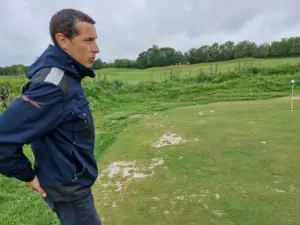A task could hardly be more difficult: develop a biodiversity program on a sports ground that is an ideal training ground for top-class sports and is used annually for a world-class golf tournament and various national championships. There are industrial estates in the surrounding area, and a subway line is being developed on the site’s edge. We are talking about Le Golf National, the venue for the golf competition of the 2024 Olympic Games, the 2018 Ryder Cup and the annual Open de France. It is an outstanding golf centre built and operated by the French Golf Federation. And because this French Golf Association is committed to sustainability, Le Golf National is also committed to sustainability and biodiversity. Maximilien Lambert, Sustainability Officer of the French Golf Federation, makes it clear: where high-end tournaments take place, there must also be room for ecology and sustainability.
Arthur Lecomte, who is the environmental advisor in the greenkeeping team, is the man on the ground trying to achieve this goal together with experts and scientists. He took his first job here in 2014, “right at the grass roots”, he says of himself. “I had a lot of gardening tasks.” He has learned to love the workplace in all its facets. And: He has an eye for detail, recognizes the small areas where ecological enhancement can be carried out. “We try to protect the environment here by sharing it with everyone,” he explains the approach. He has long been a master at discovering the niches on the high-end sports grounds that can be used as habitats for special plants or insects. There is the species-rich meadow on the slope next to a full parking lot, there are the elaborately designed fringe areas by the pond next to the entrance, which have been enhanced with coconut fibers. There are the small hedges and bushes where birds breed and for which only typical regional plants are used.
Less pesticides and optimized water management
Together with scientists from the University of Paris-Sarcly and the Muséum national d’Histoire, many sustainability projects were planned and implemented in the wake of the Ryder Cup – before the construction work for the metro line and the preparations for the Olympic tournament began. Especially on the practice greens, the extensive renunciation of pesticides has long been part of the program. The constant search for biological alternatives accompanies the greenkeepers, as does the ongoing optimization of water consumption – a constantly topical issue in France anyway. 144 kilometres of drainage have been optimized in Le Golf National so that they now drain into the ponds, which provide more biodiversity and can also be reused for irrigation.
Arthur Lecomte has also been experimenting with permaculture for years. You can tell it is particularly close to his heart. His first test area, he explains with a laugh, still had shortcomings in terms of stability, as the structure was made entirely of biomaterial from the golf course. But a second green already looks much more robust. “Permaculture may be the solution, especially for facilities with limited financial resources,” he explains. “And it means perfect recycling.” Instead of an expensive green structure, dead wood, cuttings and other materials from the site are used.
The attempt to combine top-class sport with an ecological focus is paying off. At the last species census in 2023, the scientists on site recorded 461 species, compared to 360 in 2019. “It is also possible to create small stepping stone biotopes here,” Lecomte is certain. “There’s always a possibility.” Lecomte does not allow himself to become frustrated. Not even when, as in the run-up to the Olympic Games, almost all of its meadows suddenly become mown fields. Not even if more and more areas of the site are used for the current metro line construction and therefore fall out of the biodiversity program, after all, the construction of the metro also means that golfers can travel by public transport in the future. This reduces CO₂ emissions. This also makes Le Golf National a little more sustainable.










